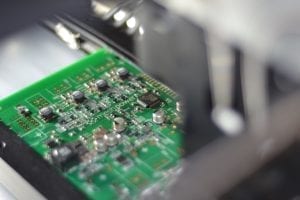Many talk about using technology to better the lives of people, but few manage to do it like MeshPower. This company, based in England, installs small solar-powered grids in rural parts of Rwanda to bring affordable and reliable electricity to entire communities that had to previously depend on expensive batteries or simply live in the dark. Last August, MeshPower celebrated its 1,000th customer. Today, they are doubling that number, and are hoping to reach 2,400 households by the end of the year. They are experiencing massive growth because they have an efficient technology and they clearly understand the challenges people face in this region of the world, and it is an honor for ST to be an integral part of their endeavor.
One of MeshPower’s biggest accomplishment was the development of a system that’s compatible with the area’s economy. Most customers can only afford to pay three to four dollars a month, and because many of them have seasonal farming activities, one must account for the fact that income is not constant all year round. Hence, MeshPower designed a nano-grid that can reach up to 50 homes and small businesses. Scale means that after a certain number of people have signed up, adding new customers to a grid costs virtually nothing. Therefore, despite the clients’ limited purchasing power, MeshPower is able to grow quickly and bring their technology to other communities. Furthermore, customers can choose a pay-as-you-go service to better manage their bills according to their needs and finances, making their access to electricity affordable and flexible.
STM32F4 And Cost

This is possible thanks in part to a little box, installed in the customers’ home, which delivers power and monitors their usage. This device uses an STM32F4 microcontroller (MCU), the same family of chips found in solar-powered cars. Engineers at MeshPower started to use the component because it was the first readily available Cortex M4 architecture MCU when they were designing their product in 2012. Subsequently, they got hooked on ST’s chips because of specific features that proved to be essential.
For instance, they were able to use a wide range of STM32F4 products because they all enjoyed the same peripheral and pin-to-pin compatibility. For MeshPower, this meant that it was possible to design on a more expensive component, then use a lower-cost MCU in the final device while using pretty much the same code base and compile it to execute with minimal effort. In some cases, there were absolutely no changes required except for the linker file.
STM32F4 And Opportunity

When cost is your primary constraint, such flexibility is liberating because it becomes possible to more easily design affordable products. The STM32 also proved to be a powerful ally in simplifying the box’s design. Charith Amarasinghe, CTO of MeshPower, explains that:
“Doing as much as possible in software is really advantageous because it helps us bring the bill of materials down. Hence, we try to get rid of intermediate components that don’t scale well or add complexity.
For instance, by using the STM32’s analog-to-digital-converters, and timers, MeshPower was able to drive their device’s LEDs by only using a software solution. It meant they could get rid of components that cost more than a dollar and a half per unit and didn’t scale well. As the company looks at other software optimizations, Mr. Amarasinghe explains that:
“We are also using an STM32 MCU because we are looking to use its more advanced capabilities in the future to offload as much as possible to software-controlled processes.”
More Power to the People

Each box delivers about 40 W to 60 W, which powers LED lights, charges cellphones or tablets and even enables the use of a TV. People can therefore study longer at night or enjoy content previously unavailable. The company is even studying the possibility of bringing Internet connectivity. The devices have a life expectancy of five years, although it could be longer, but MeshPower doesn’t have enough data yet. However, despite the harsh environment, they have enjoyed very few failures, their main issue being voltage surges caused by the occasional lightning strike. This is important because it also means that MeshPower brings expertise and jobs to the people who work on their reliable design.
For instance, the company explains that the ST platform allowed them to design a software that tests the boards’ features and prints a report on the components’ status. MeshPower was thus able to bring final assembly and quality control lines to Rwanda, meaning that the company doesn’t only deliver electricity, but creates jobs and opportunities to promote and develop the talents that often go unnoticed in this part of the world.
MeshPower is much more than a business. It is the proof that technology can bring meaningful and powerful changes in people’s lives, and become a gateway to find, promote and grow the many untapped potentials in this world today. ST is proud to have products and technologies that can play such a role, because this is what life.augmented is all about.
To know more about this fantastic company and their work in Rwanda, please visit MeshPower’s website. You can also discover the amazing STM32F4 family by going to ST’s website.




